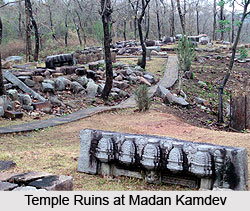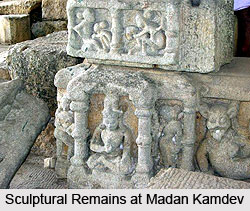 Madan Kamdev, situated in Kamrup district of Assam, is an archaeological site belonging to 9th and 10th century AD. Excavations carried out in this region have furnished various artifacts which signify the influence and opulence of Pala dynasty of Kamarupa. Madan Kamdev is a secluded place and spans over an area of 500 meters. Embraced idols of Uma Maheshwar have been carved on the temples of medieval era. However the main idols found here are Vidhyadhar`s, Ganesha`s and Sun`s. According to myths Lord Shiva had once burnt the God of Love, Kam or Madan, to ashes out of fury and Madan later took rebirth at this place.
Madan Kamdev, situated in Kamrup district of Assam, is an archaeological site belonging to 9th and 10th century AD. Excavations carried out in this region have furnished various artifacts which signify the influence and opulence of Pala dynasty of Kamarupa. Madan Kamdev is a secluded place and spans over an area of 500 meters. Embraced idols of Uma Maheshwar have been carved on the temples of medieval era. However the main idols found here are Vidhyadhar`s, Ganesha`s and Sun`s. According to myths Lord Shiva had once burnt the God of Love, Kam or Madan, to ashes out of fury and Madan later took rebirth at this place.
Geography of Madan Kamdev
Madan Kamdev hill is enclosed by tremendous variety of forests and wild animals. Dense forest covers the surrounding area and tigers can be witnessed in the adjacent hills as well. Chirruping birds make the ambience of the place pleasant amidst a captivating landscape. River Madankuri flows right below the hill in the direction from east to north. Beneath the hill there is a large stretch of swamps.
Temples at Madan Kamdev
Initially there were contradictory opinions about the construction of the temples at Madan Kamdev. However Captain Daltan documented about the ruins of 15 temples around the famous Silsako Bridge, a historical bridge demolished in the earthquake of 1857, in his Asian Society of Bengal magazine. Later it was predicted that these documentation were probably about the present Madan Kamdev. After a long break more research works were done in 1943 and 1949 which were also published in the Assam research society magazine. No further researches were carried out in Madan Kamdev till the year 1976. However during this time the villagers or hunters took away several sculptures to other places. The responsibility of the place was taken over in 1977 by the Archaeological Directorate of Assam which was followed by excavation of various ancient statues and other valuable artifacts. In addition to the main temple, remains of 12 more temples have also been unearthed. The temple architecture and the wall carvings suggest that these were erected in 10th and 12th centuries. Rulers of Pala dynasty namely Gopala, Indra Pala and Ratna Pala had constructed these temples.
 Artifacts found at Madan Kamdev
Artifacts found at Madan Kamdev
The main idols revealed in the excavation of Madan Kamdev include Saraswati, Vishnu with six heads, Kalpavriksha, four headed Shiva, Bhairava with six heads and many other idols of animals. In 1977 the area underwent renovation. Close examination of the temple and ruins found at Madan Kamdev suggests that these possess unmatched and intact beauty out of all the temple of medieval era existing in the Brahmaputra valley. There are still possibilities of the revelation of more temple ruins at Madan Kamdev.
Visiting Information to Madan Kamdev
The best time to visit this site is during winter and spring seasons. It is located 40 km away from Guwahati, from where it is easy to reach Madan Kamdev. The site is easy to reach via road. National Highway 52 connects this site to other parts of Assam. Baihata Railway Station and Lokopriya Gopinath Bordoloi International Airport at Borjhar (30 km) are the nearest to reach this place.



















